Analysis of Health Behaviours and Social Determinants in Australia
VerifiedAdded on 2023/01/16
|6
|1787
|58
Report
AI Summary
This report provides a comprehensive analysis of health behaviours and their determinants within the Australian population. It begins by defining the population and its characteristics, including demographics related to ethnicity, religion, and sexual orientation, highlighting key health conditions and statistics. The report then delves into the concept of health behaviour, emphasizing both health-promoting and health-impairing behaviours like smoking, unhealthy diets, and lack of exercise, and their consequences. It explores the importance of health behaviour change and the impact of social determinants of health, such as income, education, and employment, on health outcomes and disparities within the Australian population, with a specific focus on the Aboriginal and Torres Strait Islander communities. The report concludes by emphasizing the vital role of health in individuals' lives and the need for positive changes in health behaviours to improve overall wellbeing and reduce health inequalities. It references several studies and data to support its arguments, making it a valuable resource for anyone studying public health and related fields. The report is available on Desklib, a platform offering AI-based study tools for students.
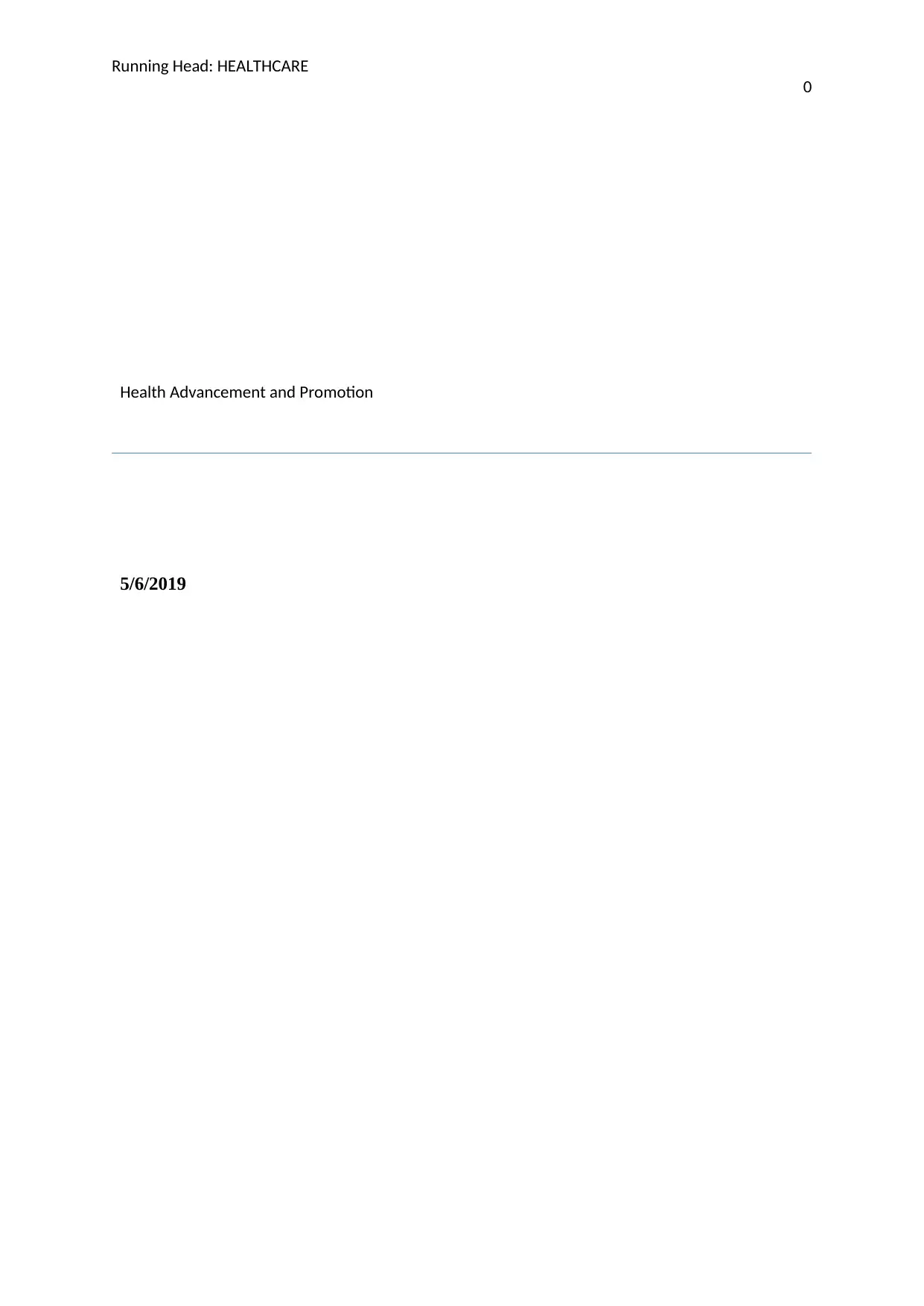
Running Head: HEALTHCARE
0
Health Advancement and Promotion
5/6/2019
0
Health Advancement and Promotion
5/6/2019
Paraphrase This Document
Need a fresh take? Get an instant paraphrase of this document with our AI Paraphraser
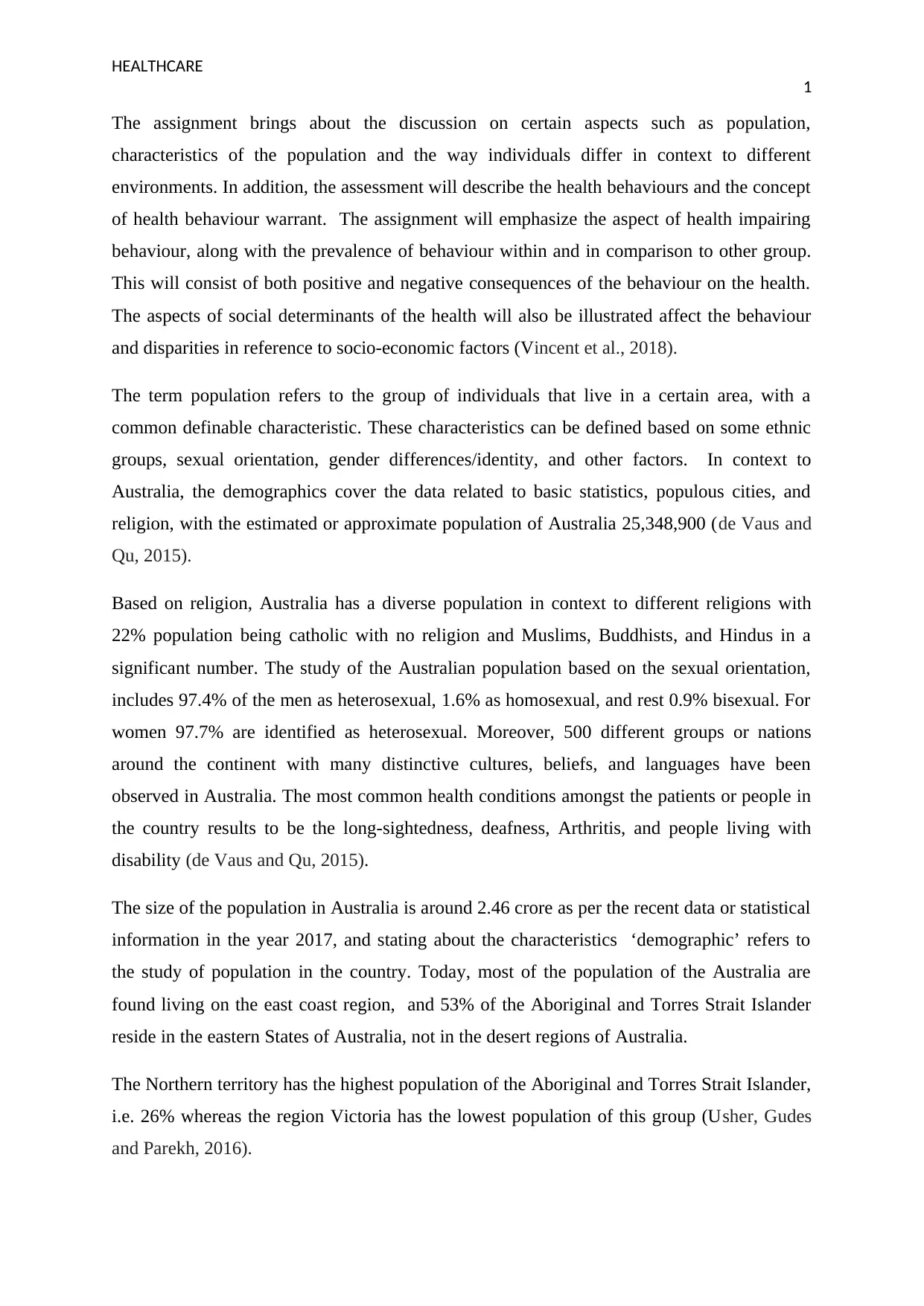
HEALTHCARE
1
The assignment brings about the discussion on certain aspects such as population,
characteristics of the population and the way individuals differ in context to different
environments. In addition, the assessment will describe the health behaviours and the concept
of health behaviour warrant. The assignment will emphasize the aspect of health impairing
behaviour, along with the prevalence of behaviour within and in comparison to other group.
This will consist of both positive and negative consequences of the behaviour on the health.
The aspects of social determinants of the health will also be illustrated affect the behaviour
and disparities in reference to socio-economic factors (Vincent et al., 2018).
The term population refers to the group of individuals that live in a certain area, with a
common definable characteristic. These characteristics can be defined based on some ethnic
groups, sexual orientation, gender differences/identity, and other factors. In context to
Australia, the demographics cover the data related to basic statistics, populous cities, and
religion, with the estimated or approximate population of Australia 25,348,900 (de Vaus and
Qu, 2015).
Based on religion, Australia has a diverse population in context to different religions with
22% population being catholic with no religion and Muslims, Buddhists, and Hindus in a
significant number. The study of the Australian population based on the sexual orientation,
includes 97.4% of the men as heterosexual, 1.6% as homosexual, and rest 0.9% bisexual. For
women 97.7% are identified as heterosexual. Moreover, 500 different groups or nations
around the continent with many distinctive cultures, beliefs, and languages have been
observed in Australia. The most common health conditions amongst the patients or people in
the country results to be the long-sightedness, deafness, Arthritis, and people living with
disability (de Vaus and Qu, 2015).
The size of the population in Australia is around 2.46 crore as per the recent data or statistical
information in the year 2017, and stating about the characteristics ‘demographic’ refers to
the study of population in the country. Today, most of the population of the Australia are
found living on the east coast region, and 53% of the Aboriginal and Torres Strait Islander
reside in the eastern States of Australia, not in the desert regions of Australia.
The Northern territory has the highest population of the Aboriginal and Torres Strait Islander,
i.e. 26% whereas the region Victoria has the lowest population of this group (Usher, Gudes
and Parekh, 2016).
1
The assignment brings about the discussion on certain aspects such as population,
characteristics of the population and the way individuals differ in context to different
environments. In addition, the assessment will describe the health behaviours and the concept
of health behaviour warrant. The assignment will emphasize the aspect of health impairing
behaviour, along with the prevalence of behaviour within and in comparison to other group.
This will consist of both positive and negative consequences of the behaviour on the health.
The aspects of social determinants of the health will also be illustrated affect the behaviour
and disparities in reference to socio-economic factors (Vincent et al., 2018).
The term population refers to the group of individuals that live in a certain area, with a
common definable characteristic. These characteristics can be defined based on some ethnic
groups, sexual orientation, gender differences/identity, and other factors. In context to
Australia, the demographics cover the data related to basic statistics, populous cities, and
religion, with the estimated or approximate population of Australia 25,348,900 (de Vaus and
Qu, 2015).
Based on religion, Australia has a diverse population in context to different religions with
22% population being catholic with no religion and Muslims, Buddhists, and Hindus in a
significant number. The study of the Australian population based on the sexual orientation,
includes 97.4% of the men as heterosexual, 1.6% as homosexual, and rest 0.9% bisexual. For
women 97.7% are identified as heterosexual. Moreover, 500 different groups or nations
around the continent with many distinctive cultures, beliefs, and languages have been
observed in Australia. The most common health conditions amongst the patients or people in
the country results to be the long-sightedness, deafness, Arthritis, and people living with
disability (de Vaus and Qu, 2015).
The size of the population in Australia is around 2.46 crore as per the recent data or statistical
information in the year 2017, and stating about the characteristics ‘demographic’ refers to
the study of population in the country. Today, most of the population of the Australia are
found living on the east coast region, and 53% of the Aboriginal and Torres Strait Islander
reside in the eastern States of Australia, not in the desert regions of Australia.
The Northern territory has the highest population of the Aboriginal and Torres Strait Islander,
i.e. 26% whereas the region Victoria has the lowest population of this group (Usher, Gudes
and Parekh, 2016).
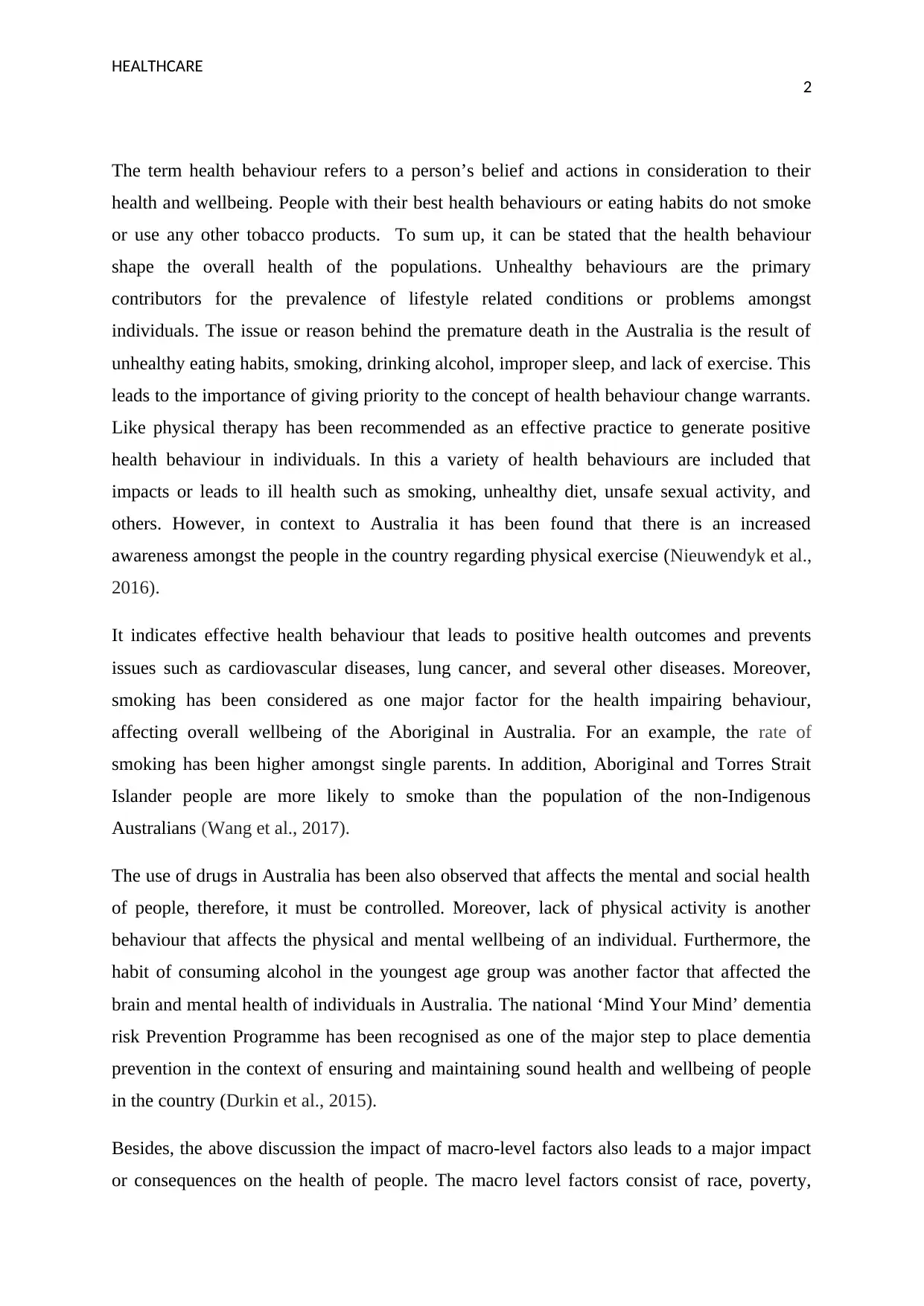
HEALTHCARE
2
The term health behaviour refers to a person’s belief and actions in consideration to their
health and wellbeing. People with their best health behaviours or eating habits do not smoke
or use any other tobacco products. To sum up, it can be stated that the health behaviour
shape the overall health of the populations. Unhealthy behaviours are the primary
contributors for the prevalence of lifestyle related conditions or problems amongst
individuals. The issue or reason behind the premature death in the Australia is the result of
unhealthy eating habits, smoking, drinking alcohol, improper sleep, and lack of exercise. This
leads to the importance of giving priority to the concept of health behaviour change warrants.
Like physical therapy has been recommended as an effective practice to generate positive
health behaviour in individuals. In this a variety of health behaviours are included that
impacts or leads to ill health such as smoking, unhealthy diet, unsafe sexual activity, and
others. However, in context to Australia it has been found that there is an increased
awareness amongst the people in the country regarding physical exercise (Nieuwendyk et al.,
2016).
It indicates effective health behaviour that leads to positive health outcomes and prevents
issues such as cardiovascular diseases, lung cancer, and several other diseases. Moreover,
smoking has been considered as one major factor for the health impairing behaviour,
affecting overall wellbeing of the Aboriginal in Australia. For an example, the rate of
smoking has been higher amongst single parents. In addition, Aboriginal and Torres Strait
Islander people are more likely to smoke than the population of the non-Indigenous
Australians (Wang et al., 2017).
The use of drugs in Australia has been also observed that affects the mental and social health
of people, therefore, it must be controlled. Moreover, lack of physical activity is another
behaviour that affects the physical and mental wellbeing of an individual. Furthermore, the
habit of consuming alcohol in the youngest age group was another factor that affected the
brain and mental health of individuals in Australia. The national ‘Mind Your Mind’ dementia
risk Prevention Programme has been recognised as one of the major step to place dementia
prevention in the context of ensuring and maintaining sound health and wellbeing of people
in the country (Durkin et al., 2015).
Besides, the above discussion the impact of macro-level factors also leads to a major impact
or consequences on the health of people. The macro level factors consist of race, poverty,
2
The term health behaviour refers to a person’s belief and actions in consideration to their
health and wellbeing. People with their best health behaviours or eating habits do not smoke
or use any other tobacco products. To sum up, it can be stated that the health behaviour
shape the overall health of the populations. Unhealthy behaviours are the primary
contributors for the prevalence of lifestyle related conditions or problems amongst
individuals. The issue or reason behind the premature death in the Australia is the result of
unhealthy eating habits, smoking, drinking alcohol, improper sleep, and lack of exercise. This
leads to the importance of giving priority to the concept of health behaviour change warrants.
Like physical therapy has been recommended as an effective practice to generate positive
health behaviour in individuals. In this a variety of health behaviours are included that
impacts or leads to ill health such as smoking, unhealthy diet, unsafe sexual activity, and
others. However, in context to Australia it has been found that there is an increased
awareness amongst the people in the country regarding physical exercise (Nieuwendyk et al.,
2016).
It indicates effective health behaviour that leads to positive health outcomes and prevents
issues such as cardiovascular diseases, lung cancer, and several other diseases. Moreover,
smoking has been considered as one major factor for the health impairing behaviour,
affecting overall wellbeing of the Aboriginal in Australia. For an example, the rate of
smoking has been higher amongst single parents. In addition, Aboriginal and Torres Strait
Islander people are more likely to smoke than the population of the non-Indigenous
Australians (Wang et al., 2017).
The use of drugs in Australia has been also observed that affects the mental and social health
of people, therefore, it must be controlled. Moreover, lack of physical activity is another
behaviour that affects the physical and mental wellbeing of an individual. Furthermore, the
habit of consuming alcohol in the youngest age group was another factor that affected the
brain and mental health of individuals in Australia. The national ‘Mind Your Mind’ dementia
risk Prevention Programme has been recognised as one of the major step to place dementia
prevention in the context of ensuring and maintaining sound health and wellbeing of people
in the country (Durkin et al., 2015).
Besides, the above discussion the impact of macro-level factors also leads to a major impact
or consequences on the health of people. The macro level factors consist of race, poverty,
⊘ This is a preview!⊘
Do you want full access?
Subscribe today to unlock all pages.

Trusted by 1+ million students worldwide
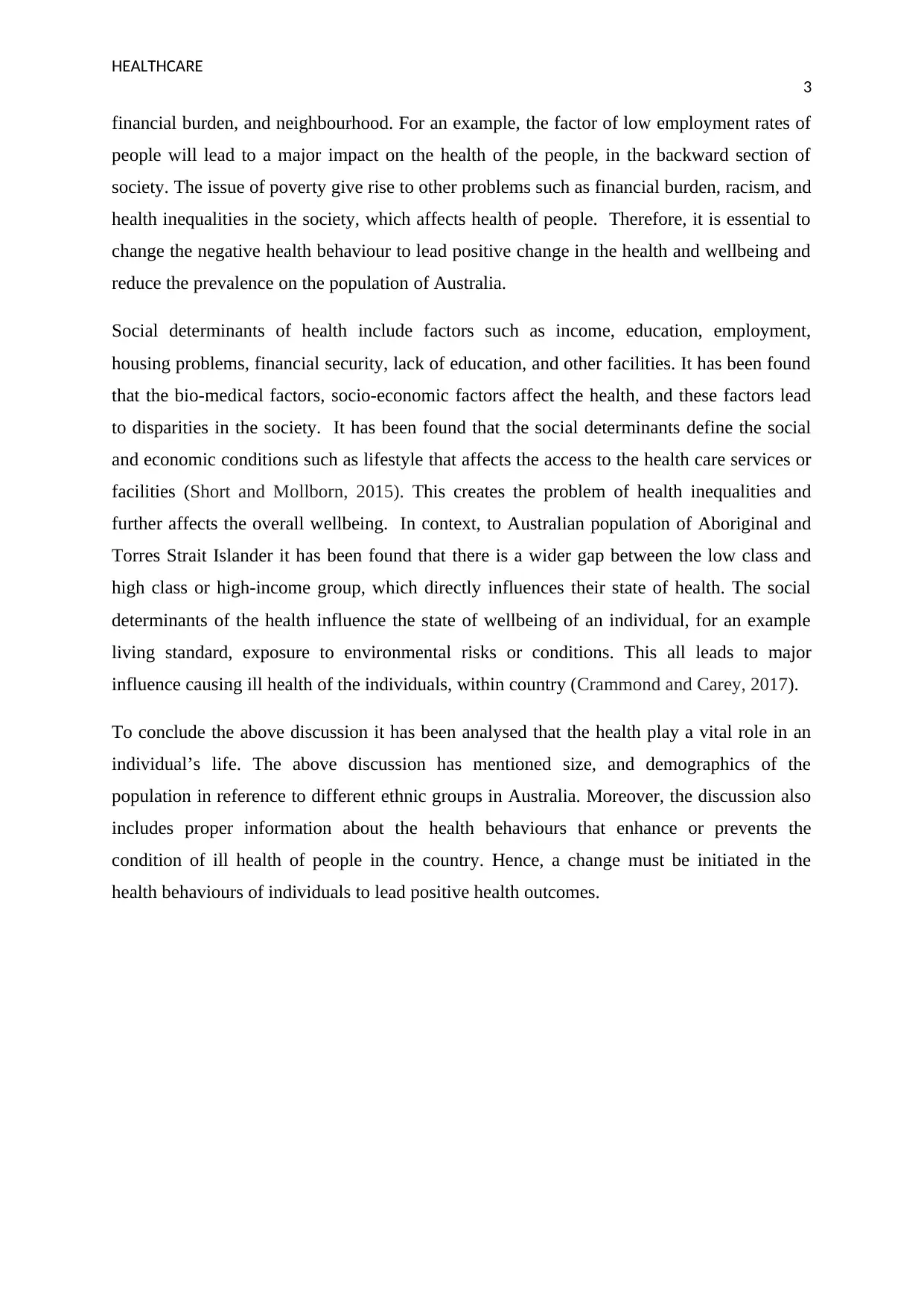
HEALTHCARE
3
financial burden, and neighbourhood. For an example, the factor of low employment rates of
people will lead to a major impact on the health of the people, in the backward section of
society. The issue of poverty give rise to other problems such as financial burden, racism, and
health inequalities in the society, which affects health of people. Therefore, it is essential to
change the negative health behaviour to lead positive change in the health and wellbeing and
reduce the prevalence on the population of Australia.
Social determinants of health include factors such as income, education, employment,
housing problems, financial security, lack of education, and other facilities. It has been found
that the bio-medical factors, socio-economic factors affect the health, and these factors lead
to disparities in the society. It has been found that the social determinants define the social
and economic conditions such as lifestyle that affects the access to the health care services or
facilities (Short and Mollborn, 2015). This creates the problem of health inequalities and
further affects the overall wellbeing. In context, to Australian population of Aboriginal and
Torres Strait Islander it has been found that there is a wider gap between the low class and
high class or high-income group, which directly influences their state of health. The social
determinants of the health influence the state of wellbeing of an individual, for an example
living standard, exposure to environmental risks or conditions. This all leads to major
influence causing ill health of the individuals, within country (Crammond and Carey, 2017).
To conclude the above discussion it has been analysed that the health play a vital role in an
individual’s life. The above discussion has mentioned size, and demographics of the
population in reference to different ethnic groups in Australia. Moreover, the discussion also
includes proper information about the health behaviours that enhance or prevents the
condition of ill health of people in the country. Hence, a change must be initiated in the
health behaviours of individuals to lead positive health outcomes.
3
financial burden, and neighbourhood. For an example, the factor of low employment rates of
people will lead to a major impact on the health of the people, in the backward section of
society. The issue of poverty give rise to other problems such as financial burden, racism, and
health inequalities in the society, which affects health of people. Therefore, it is essential to
change the negative health behaviour to lead positive change in the health and wellbeing and
reduce the prevalence on the population of Australia.
Social determinants of health include factors such as income, education, employment,
housing problems, financial security, lack of education, and other facilities. It has been found
that the bio-medical factors, socio-economic factors affect the health, and these factors lead
to disparities in the society. It has been found that the social determinants define the social
and economic conditions such as lifestyle that affects the access to the health care services or
facilities (Short and Mollborn, 2015). This creates the problem of health inequalities and
further affects the overall wellbeing. In context, to Australian population of Aboriginal and
Torres Strait Islander it has been found that there is a wider gap between the low class and
high class or high-income group, which directly influences their state of health. The social
determinants of the health influence the state of wellbeing of an individual, for an example
living standard, exposure to environmental risks or conditions. This all leads to major
influence causing ill health of the individuals, within country (Crammond and Carey, 2017).
To conclude the above discussion it has been analysed that the health play a vital role in an
individual’s life. The above discussion has mentioned size, and demographics of the
population in reference to different ethnic groups in Australia. Moreover, the discussion also
includes proper information about the health behaviours that enhance or prevents the
condition of ill health of people in the country. Hence, a change must be initiated in the
health behaviours of individuals to lead positive health outcomes.
Paraphrase This Document
Need a fresh take? Get an instant paraphrase of this document with our AI Paraphraser

HEALTHCARE
4
4
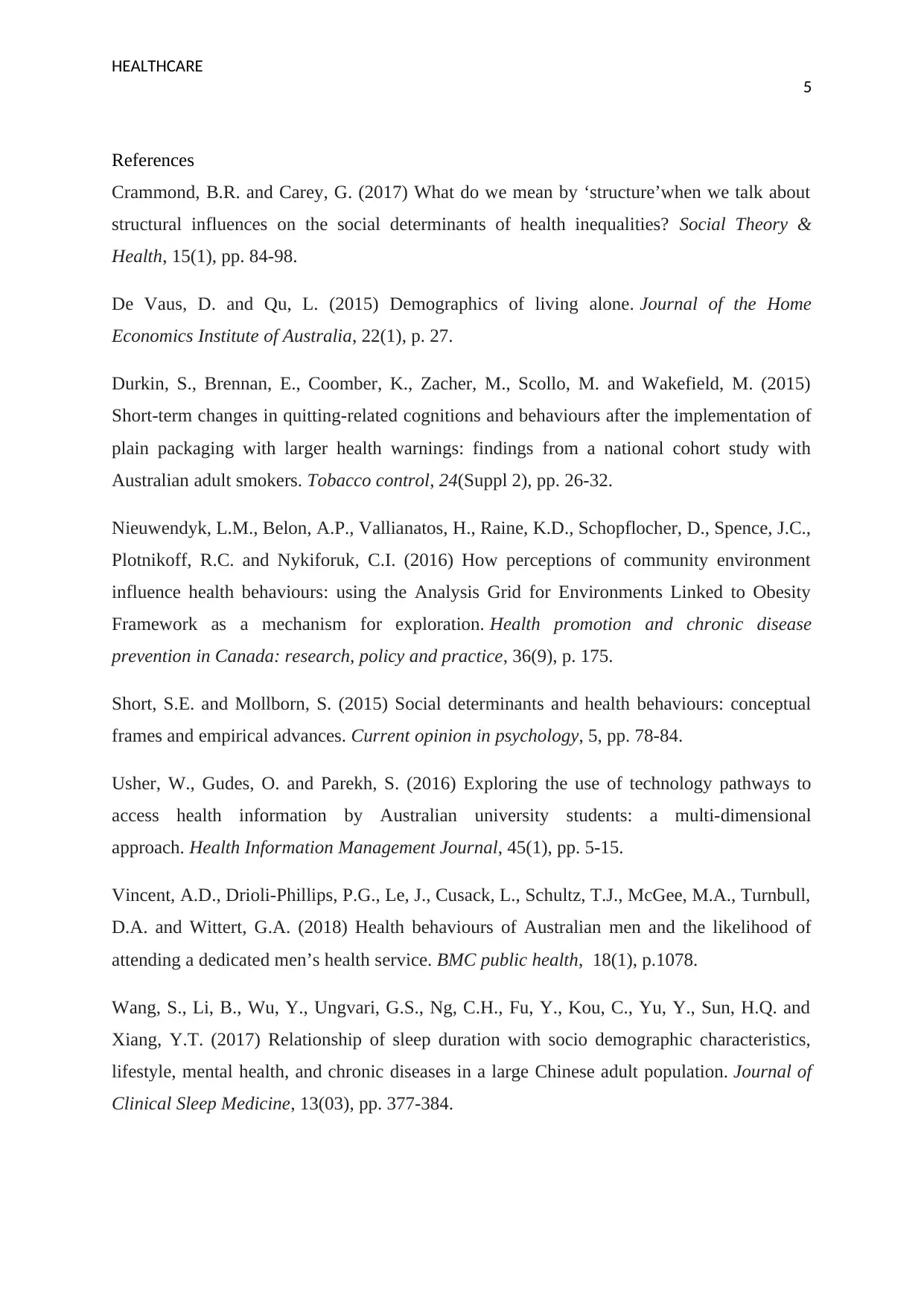
HEALTHCARE
5
References
Crammond, B.R. and Carey, G. (2017) What do we mean by ‘structure’when we talk about
structural influences on the social determinants of health inequalities? Social Theory &
Health, 15(1), pp. 84-98.
De Vaus, D. and Qu, L. (2015) Demographics of living alone. Journal of the Home
Economics Institute of Australia, 22(1), p. 27.
Durkin, S., Brennan, E., Coomber, K., Zacher, M., Scollo, M. and Wakefield, M. (2015)
Short-term changes in quitting-related cognitions and behaviours after the implementation of
plain packaging with larger health warnings: findings from a national cohort study with
Australian adult smokers. Tobacco control, 24(Suppl 2), pp. 26-32.
Nieuwendyk, L.M., Belon, A.P., Vallianatos, H., Raine, K.D., Schopflocher, D., Spence, J.C.,
Plotnikoff, R.C. and Nykiforuk, C.I. (2016) How perceptions of community environment
influence health behaviours: using the Analysis Grid for Environments Linked to Obesity
Framework as a mechanism for exploration. Health promotion and chronic disease
prevention in Canada: research, policy and practice, 36(9), p. 175.
Short, S.E. and Mollborn, S. (2015) Social determinants and health behaviours: conceptual
frames and empirical advances. Current opinion in psychology, 5, pp. 78-84.
Usher, W., Gudes, O. and Parekh, S. (2016) Exploring the use of technology pathways to
access health information by Australian university students: a multi-dimensional
approach. Health Information Management Journal, 45(1), pp. 5-15.
Vincent, A.D., Drioli-Phillips, P.G., Le, J., Cusack, L., Schultz, T.J., McGee, M.A., Turnbull,
D.A. and Wittert, G.A. (2018) Health behaviours of Australian men and the likelihood of
attending a dedicated men’s health service. BMC public health, 18(1), p.1078.
Wang, S., Li, B., Wu, Y., Ungvari, G.S., Ng, C.H., Fu, Y., Kou, C., Yu, Y., Sun, H.Q. and
Xiang, Y.T. (2017) Relationship of sleep duration with socio demographic characteristics,
lifestyle, mental health, and chronic diseases in a large Chinese adult population. Journal of
Clinical Sleep Medicine, 13(03), pp. 377-384.
5
References
Crammond, B.R. and Carey, G. (2017) What do we mean by ‘structure’when we talk about
structural influences on the social determinants of health inequalities? Social Theory &
Health, 15(1), pp. 84-98.
De Vaus, D. and Qu, L. (2015) Demographics of living alone. Journal of the Home
Economics Institute of Australia, 22(1), p. 27.
Durkin, S., Brennan, E., Coomber, K., Zacher, M., Scollo, M. and Wakefield, M. (2015)
Short-term changes in quitting-related cognitions and behaviours after the implementation of
plain packaging with larger health warnings: findings from a national cohort study with
Australian adult smokers. Tobacco control, 24(Suppl 2), pp. 26-32.
Nieuwendyk, L.M., Belon, A.P., Vallianatos, H., Raine, K.D., Schopflocher, D., Spence, J.C.,
Plotnikoff, R.C. and Nykiforuk, C.I. (2016) How perceptions of community environment
influence health behaviours: using the Analysis Grid for Environments Linked to Obesity
Framework as a mechanism for exploration. Health promotion and chronic disease
prevention in Canada: research, policy and practice, 36(9), p. 175.
Short, S.E. and Mollborn, S. (2015) Social determinants and health behaviours: conceptual
frames and empirical advances. Current opinion in psychology, 5, pp. 78-84.
Usher, W., Gudes, O. and Parekh, S. (2016) Exploring the use of technology pathways to
access health information by Australian university students: a multi-dimensional
approach. Health Information Management Journal, 45(1), pp. 5-15.
Vincent, A.D., Drioli-Phillips, P.G., Le, J., Cusack, L., Schultz, T.J., McGee, M.A., Turnbull,
D.A. and Wittert, G.A. (2018) Health behaviours of Australian men and the likelihood of
attending a dedicated men’s health service. BMC public health, 18(1), p.1078.
Wang, S., Li, B., Wu, Y., Ungvari, G.S., Ng, C.H., Fu, Y., Kou, C., Yu, Y., Sun, H.Q. and
Xiang, Y.T. (2017) Relationship of sleep duration with socio demographic characteristics,
lifestyle, mental health, and chronic diseases in a large Chinese adult population. Journal of
Clinical Sleep Medicine, 13(03), pp. 377-384.
⊘ This is a preview!⊘
Do you want full access?
Subscribe today to unlock all pages.

Trusted by 1+ million students worldwide
1 out of 6
Related Documents
Your All-in-One AI-Powered Toolkit for Academic Success.
+13062052269
info@desklib.com
Available 24*7 on WhatsApp / Email
![[object Object]](/_next/static/media/star-bottom.7253800d.svg)
Unlock your academic potential
Copyright © 2020–2025 A2Z Services. All Rights Reserved. Developed and managed by ZUCOL.





